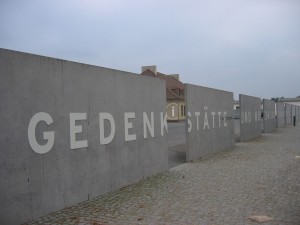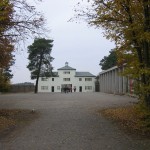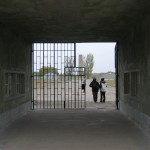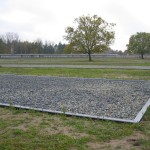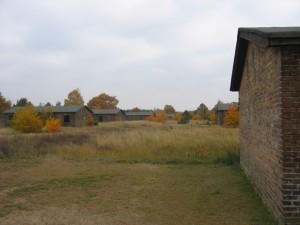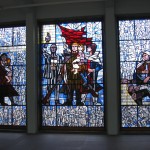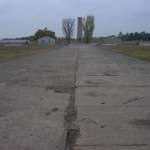KZ Sachsenhausen: four layers of memory
Our visit to Buchenwald last weekend left us all with much to think about concerning the troublesome history of the Holocaust and the aftermath of WWII. This past Friday, we visited another concentration camp site, this time much nearer to Berlin. As opposed to Buchenwald, which is somewhat removed from the town of Weimar, Sachsenhausen is set essentially within the town of Oranienburg. The students were shocked to see how close the camp was to the surrounding houses: it reveals much about the attitude of many Germans toward the existence of these sites during the Nazi era.
The exhibitions and interpretive materials on the site (which is still in the process of being remodeled) seek to reveal four major eras in the camp’s existence. The first is the building and use of the camp by the Nazis, beginning in 1936. Though many Jews were imprisoned here, it was better known as a camp for political prisoners, especially Communists. It was also a prominent training site for the SS, as well as a “show” camp for Hitler and his officials. Though it wasn’t a death camp, tens of thousands of prisoners died here as a result of starvation, disease, abuse, and torture, as well as medical experiments.
After the war, the Soviets used Sachsenhausen as a “special camp” where they held various German prisoners to await trial. (Above: extra housing outside the camp walls which was used during this time.) Several thousand people died during this stage of the camp’s existence – mostly of starvation, disease and exposure. It’s difficult to know what to do with the memory of these deaths, as many of the prisoners were either Nazis themselves, or had been willing participants in the culture of the regime. Still, the evidence of human suffering here is also staggering.
After the Soviets abandoned the camp, the GDR government refurbished it (as they did Buchenwald) as a memorial site. Here at Sachsenhausen, this included a large memorial structure (where soldiers were regularly inducted into the army), as well as a museum that emphasized the suffering of the Communist prisoners held here by the Nazis. For East Germany, the identity of the Communists as victims of the fascist regime was a central part of the national narrative, so sites like these became points for the public expression of collective persecution at the hands of the Nazis – even if very few GDR citizens had actually been Communists prior to 1945. On the other hand, the memory of the Soviet camp was completely suppressed under the East Germans, so that families who had lost loved ones here during the post-war period were unable to speak about their own suffering until after 1989.
With the fall of the wall, the camp became a flashpoint for conflicting narratives and memories: how can both victims of the Nazis and Nazis or collaborators themselves be remembered and mourned on the same site? This is a question that haunts many spaces in Berlin, not only Sachsenhausen. The current design of the site attempts to deal with this through a “decentralized” approach, using the various structures to house extensive exhibitions of archival material. Still, we’re left wondering: how do we decide who has the right to be remembered, and how?
There are many more buildings on the site, but I couldn’t bring myself to photograph them. Sites of terrible suffering and unspeakable crimes, I think they are best left to be pondered in the abstract. If you’re interested, however, you can read more about the site here.
tags
the author
I'm a doctoral student at CUNY Graduate Center. I'm thrilled to be teaching the CHID Berlin program with Prof. John Toews! You can contact me at naraelle [at] gmail.com, or find out more about me at www.naraelle.net.
Blogroll
- Annie Holden's blog
- Cassie Hoeprich's blog
- Dominic Barrera's blog
- Janet Williams's blog
- Mariah Alderete's blog
- Melissa Au's blog
- Robert Hampton's blog
- UW Students Study Abroad Our students Natalie and Cassie are contributing to the official IPE student blog this fall!



